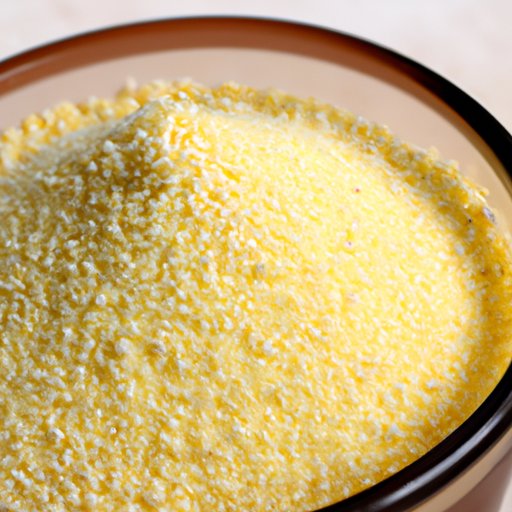
I. Introduction
Gluten has become a buzzword in health and nutrition circles over the last few years. The growing popularity of gluten-free diets has led to an increase in awareness of the risks associated with consuming gluten and the need for gluten-free alternatives. One such alternative is millet flour, a gluten-free flour made from ground millet grains. In this article, we will explore the nutritional content of millet flour, its advantages, and the best ways to use millet flour in your gluten-free baking and cooking.
II. What is Millet Flour?
Millet is a gluten-free cereal grain that is widely grown across Asia, Africa, and India. The grains of millet are dried and ground into flour, which can be used as a gluten-free alternative to wheat flour. Millet flour is high in protein, fiber, and essential nutrients such as iron and magnesium. It is also a good source of antioxidants, making it an excellent choice for anyone looking for a nutritious and gluten-free alternative to wheat flour.
III. Is Millet Flour the Perfect Gluten-Free Alternative for Your Baking?
Millet flour is an excellent alternative to wheat flour for gluten-free baking and cooking. It has a mild, sweet flavor that works well in sweet baked goods such as cakes and cookies. Its smooth texture makes it ideal for creating light and fluffy baked goods. Additionally, millet flour has a low glycemic index, which means it is released slowly into the bloodstream, helping to regulate blood sugar levels.
However, using millet flour for gluten-free baking does have some potential drawbacks. Millet flour can be denser than wheat flour, which can result in denser baked goods if not used correctly. Additionally, millet flour has a shorter shelf life than wheat flour and can go rancid quickly if not stored correctly. Therefore, it is crucial to store millet flour in a cool, dry place to prevent spoilage.
IV. The Benefits of Millet Flour for a Gluten-Free Lifestyle
Millet flour has several nutritional benefits that make it an excellent choice for gluten-free eaters. It is high in protein, fiber, and essential nutrients such as iron and magnesium. Additionally, millet flour is low in calories, making it an excellent choice for anyone trying to maintain a healthy weight.
Research has also suggested that millet flour may have additional health benefits. Studies have shown that it may help lower cholesterol levels, reduce the risk of cardiovascular disease, and improve digestion.
V. A Comprehensive Guide to Understanding Millet Flour and Gluten-Free Foods
If you’re new to using millet flour in your gluten-free baking, it can be helpful to understand how to use it correctly. One key thing to keep in mind is that millet flour absorbs moisture differently than wheat flour. Therefore, it is essential to adjust your recipe to factor in the difference in moisture absorption. As a general rule, you should reduce the amount of millet flour used by up to 25% and increase the amount of liquid used by a similar amount.
Millet flour can be used in a wide range of gluten-free baked goods, from bread and muffins to cakes and cookies. It can also be used as a thickener in sauces and stews. When using millet flour, it is essential to combine it with other gluten-free flours, such as rice flour or tapioca flour, to achieve the desired texture and flavor profile.
VI. Millet Flour: The Secret to Delicious Gluten-Free Baked Goods
Millet flour can be used to create delicious, light, and fluffy gluten-free baked goods. Here are some recipes to get you started:
- Gluten-free chocolate chip cookies – replace the wheat flour with a combination of millet flour, rice flour, and tapioca flour
- Gluten-free bread – use a combination of millet flour and almond flour to create a light and fluffy loaf
- Gluten-free pancakes – replace the wheat flour with millet flour for a slightly sweet and more nutritious pancake
When using millet flour in baking, it is essential to play around with different flour ratios and techniques to achieve the desired texture and flavor profile. The key is to experiment and have fun!
VII. Gluten-Free Baking Made Easy with Millet Flour
Using millet flour in your gluten-free baking is easy and straightforward. Simply substitute it for wheat flour in your favorite recipes and adjust the moisture levels accordingly. Millet flour is readily available at most health food stores and online retailers. It is also relatively inexpensive, making it an accessible option for anyone looking to switch to a gluten-free diet.
VIII. Why Millet Flour is a Must-Have Ingredient in Your Gluten-Free Pantry
There are many reasons why millet flour is a must-have ingredient in your gluten-free pantry. It is an excellent source of nutrients, is versatile in its uses, and can help you achieve light and fluffy baked goods that are both nutritious and delicious. Additionally, it is an affordable and accessible alternative to wheat flour. Investing in some millet flour is an excellent way to add variety and nutrition to your gluten-free diet, and we highly recommend giving it a try.
IX. Conclusion
Millet flour is a fantastic gluten-free alternative to wheat flour. It is high in nutrients, versatile and easy to use in baking and cooking. While using millet flour in your gluten-free baking can have some potential drawbacks, these can be easily overcome by adjusting your recipe and storing your flour correctly.





